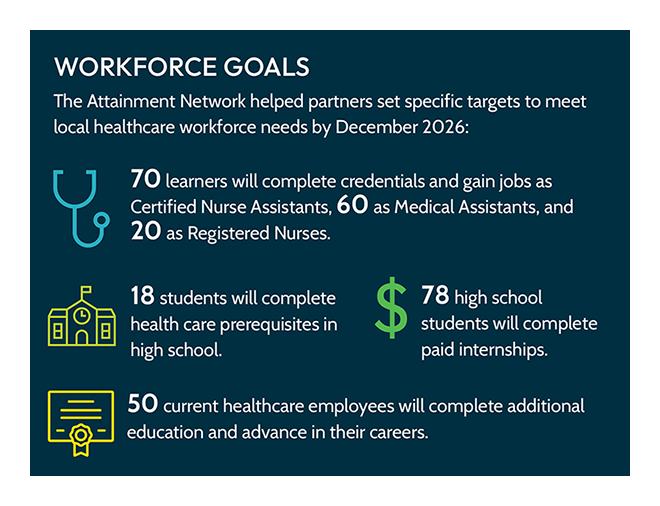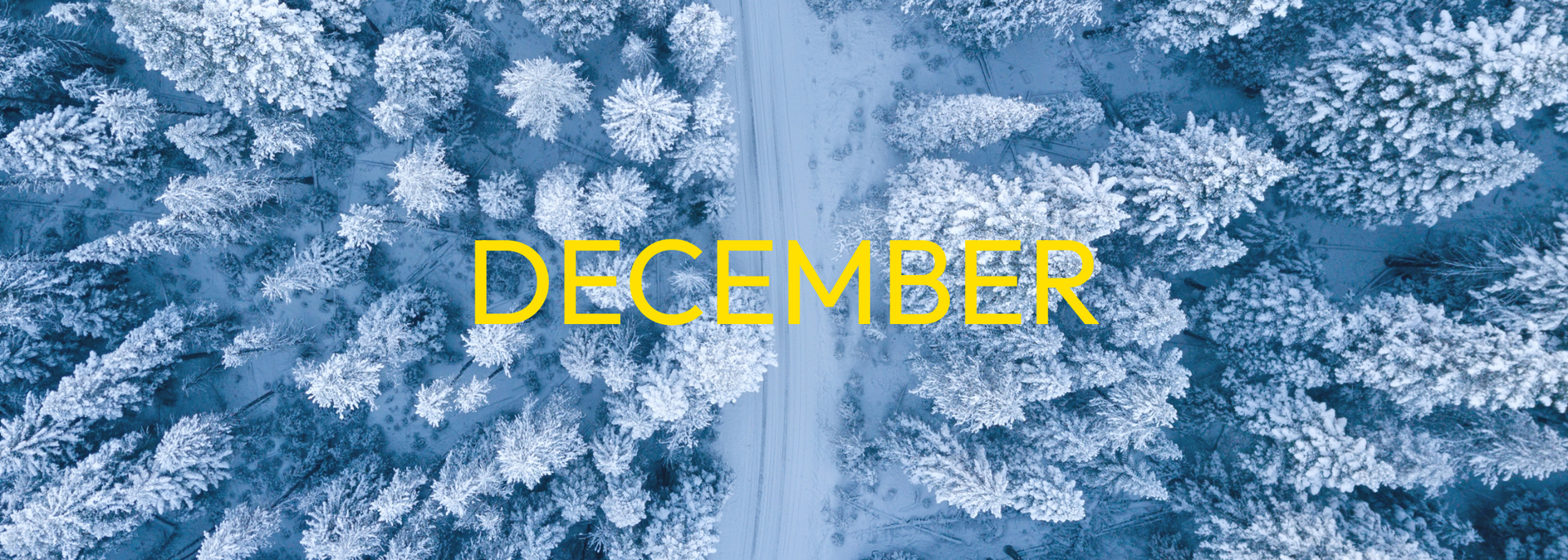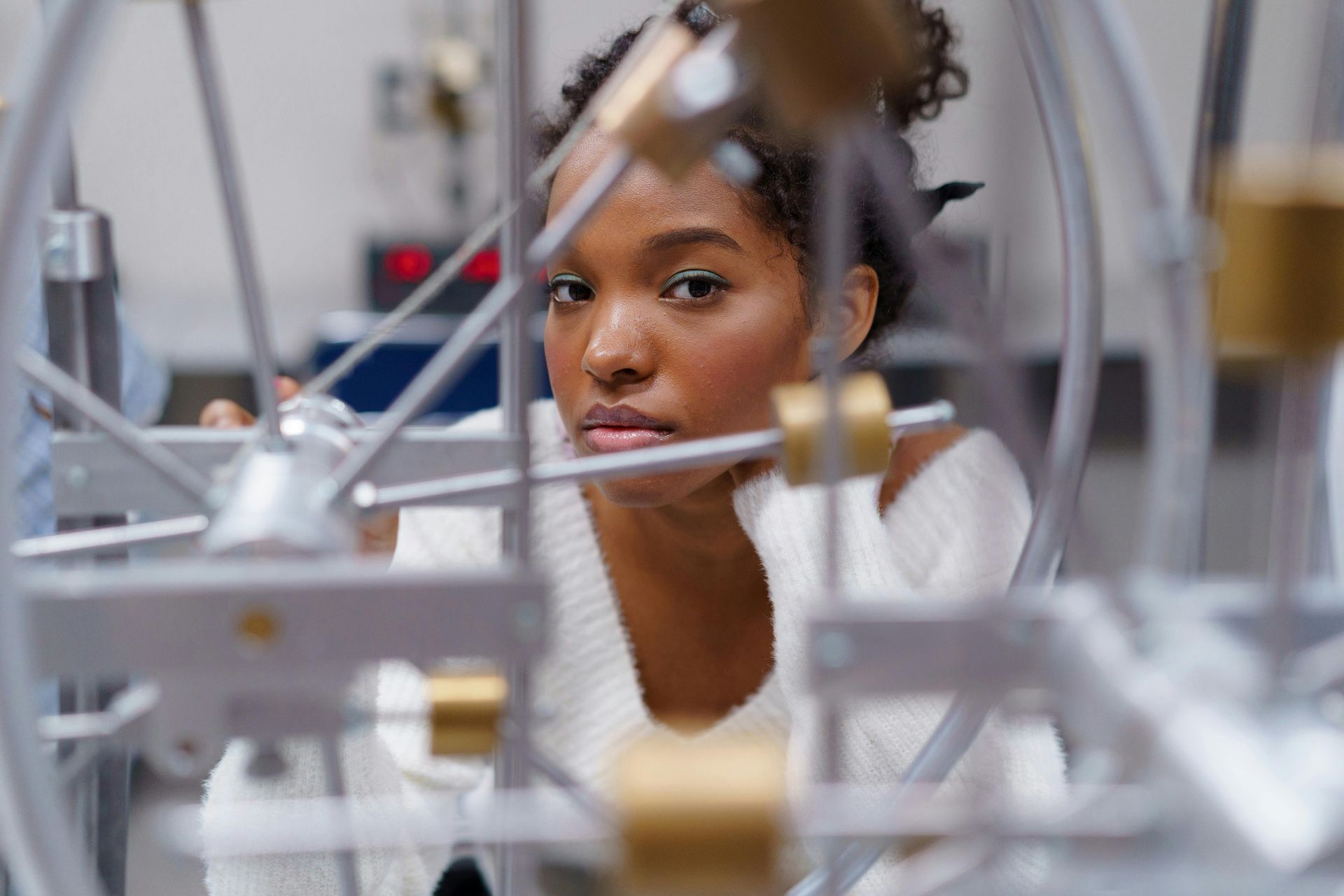Meeting healthcare workforce needs and expanding hope and opportunity for learners

Beneath the breathtaking Sangre de Cristo and San Juan mountain ranges, the communities in the San Luis Valley are grappling with some of the state’s highest poverty rates and an economy constrained by a critical shortage of skilled workers.
With more than 20 percent of the population in some Valley communities living below the federal poverty level, there is a pervasive sense of “generational hopelessness” among the local youth, according to longtime resident Rachael Cheslock. Rachael is the coordinator of work-based learning opportunities at Adams State University, and she says many students don’t feel like there are any opportunities for them to work in a meaningful career and make enough income to support a family.
The Attainment Network is working alongside local employers, higher education, community organizations, and school districts to bolster their efforts to rewrite this narrative of despair into one of promise and prosperity.
Initial focus is on the healthcare sector, one of the most impacted by the lack of skilled workers. With a total healthcare workforce of around 1,100 in the Valley, leaders predict 300 healthcare positions will go unfilled this year.
The Attainment Network’s partnership is working to transform the Valley’s education-to-workforce systems to fill many of these positions. With all 14 school districts on board, along with Trinidad State College, Adams State University, five community organizations, and four different health care employers, the partnership has specific targets for meeting critical needs for healthcare workers in the Valley. But its biggest achievement will be to instill hope and bring real economic opportunity to learners and earners in the Valley.
In listening sessions conducted with healthcare employers, partners identified the root causes of the labor shortages – the community was losing talent to urban centers, while the remaining talent pool lacked access to education and skills training, as well as durable skills, to move into, or advance, in healthcare careers.
At the same time, community listening sessions revealed that potential healthcare employees – from learners in high schools to current healthcare employees in entry-level jobs – are interested in starting or advancing in health care careers but face a number of barriers, including basic needs like lack of transportation to attend classes and gaps in childcare, the inability to afford tuition, and even simple awareness of opportunities.
The Attainment Network helped partners set specific targets to meet local workforce needs by December 2026, and by October 2025 we made significant progress:
- We’ve already met our goal of training 70 new CNAs, and we’re 73% of the way toward our goal of training 60 new Medical Assistants.
- We’ve reached 72% of our goal to place 78 learners in paid healthcare internships.
- We’re 42% of the way toward our goal of upskilling 50 earners
The next step in the process was to develop the shared strategy to reach the targets. The Attainment Network guided partners in developing this three-pronged strategy:
- Increase early access to healthcare prerequisites: School districts, higher education and employers will collaborate to increase opportunities for high school learners to attain CNA and MA credentials before they graduate,
- Expand work-based learning: Community organizations, school districts, Adams State University, and Trinidad State College will expand industry-informed work-based learning opportunities, such as internships and career exploration events, for high school learners to gain real-world experiences, and
- Upskill current entry-level employees: Employers and higher education will work together to provide “upskilling” opportunities and wrap-around support – including financial assistance, transportation and child care – for current staff to increase their education and move up the career ladder.

Increasing early access to healthcare prerequisites
Wendy Murillo, a nurse for the Center School District, is blazing a path for her students to enter healthcare careers, setting an example for other districts.
Many students in Center are from immigrant families and will be among the first generation in their family to graduate from high school. Wendy launched and teaches the Certified Nurse Assistant course at Center High School to give students a launchpad into a healthcare career.
“I want them to be able to leave school and be able to have a decent job… to support a family,” Murillo said. “It’s great if they want to pursue higher education, but if for some reason it doesn’t work out, at least they’ll have something to fall back on.”
She worked with Trinidad State College to set up the program, and with full support from her superintendent, she secured funding from her district for much of the equipment and supplies they needed. After learning about the Career Development Incentives Program from The Attainment Network, Wendy was also able to tap into funding from that program, which provides districts with money for students who complete in-demand industry certificate programs.
Of her current students, some have plans to attend college and ultimately become a nurse or another health care professional. Others simply want to finish high school with a credential that will help them get a good-paying job.
Next stop for Wendy is to set up a full CTE pathway in Center to help students obtain all the prerequisites they might need to enter a postsecondary program in health care at Trinidad State College, Adams State University, or any other program in Colorado.
Exposing learners to the opportunities available through a career in healthcare is one of her objectives. “A lot of them are interested, but they don’t really know what the medical field is about.” Some will want to enter careers in healthcare after completing the CNA course, and some may not, “but they don’t know that until they’re in the field and they get their feet wet.”
As a front-runner in crafting nursing career pathways, the Center School District, under Wendy’s guidance, is poised to be a model for others. The Attainment Network plans to leverage Wendy’s insights to support other districts, potentially enabling students at nearby districts to participate in the CNA program she teaches and mobilizing her as an advocate for the establishment of similar pathways throughout the Valley.
Expanding work-based learning
Boys & Girls Clubs of the San Luis Valley brings to the partnership a deep expertise in working with employers to provide internships aligned with the skills they need as well as students’ interests. Olivia How, extended learning program director, has been leveraging her connections as a lifelong resident of the Valley to secure internships for learners in a wide variety of fields – dental care, architecture, physical therapy and entrepreneurship, for example.
With the support from The Attainment Network and other community partners, she aims to provide 78 paid internships in healthcare fields and coordinate wrap-around services learners may need. The wrap-around services are for things like financial support, housing assistance, and transportation – anything that is posing a barrier to learners participating in the program.
“The sooner we can get them in to start learning about that field, the better it’s going to be,” Olivia said. “Hopefully it’s going to return to our community because we’re going to be able to keep that workforce here, to grow our own workforce. And that is so important because so many students in the Valley leave and feel like they don’t have an opportunity to make decent wages here.”
One of the partners with whom Olivia works closely is another lifelong resident of the Valley, Rachael Cheslock from Adams State University, who coordinates work-based learning in the Valley.
Rachael works directly with teachers to find out what their students are interested in, and then she uses her deep community connections to create work-based learning or career exploration opportunities for them.
She often has to get creative in order to accommodate challenges students face, sometimes placing students in internships right at their school if they don’t have transportation. Helping with a school’s IT or communications can be a meaningful internship, as is helping the school nurse.
For Rachael, the partnership’s success isn’t measured by numbers alone but by the ability to open doors for students who feel they lack opportunities.
“The whole point of this was really to reach the ones who are furthest from access,” Rachael said.
Upskilling current healthcare employees
Amidst a national labor shortage of nurses that is especially prevalent in the San Luis Valley, Brittany Sours, the Professional Development and Practice Specialist at San Luis Valley Health, has been striving for years to expand the local healthcare workforce. She knows local school districts and higher education have also been trying to build up the local healthcare workforce, but progress has been slow.
But she sees real momentum building now with the partnership forged by The Attainment Network.
“It’s really cool to be working with The Attainment Network because they have the time to bring all of these partners together so that we can collaborate more and not have a siloed effect,” Sours said.
Previously working more or less independently, San Luis Valley Health, as well as the schools and higher education institutions, lacked the structure and systems to work together to identify and address all barriers facing learners. With leadership, strategic direction, project management and financial resources now provided by The Attainment Network, the partners are able to work collectively to identify the barriers and collaborate on solutions to make it easier for people to enter into, or advance in, health care careers.
“One of the best things with working with The Attainment Network is – even with all the challenges and barriers – they just maintain this really great positive attitude of, we are going to get there. It’s really been nice to have this constant direction on – where can we get the yeses, and how can we make things happen.”
One barrier that school districts have already lifted up relates to the goal of providing early exposure to healthcare careers for high school students. San Luis Valley Health, like many other healthcare facilities, required interns and other learners at the hospital to be at least 18 years old.
Working together, the partners elevated the need to provide high school students with opportunities to see various careers in action. With the barrier clearly identified, SLV Health took a second look at their policy, and found a way to maintain the highest levels of patient care and trust while creating specific avenues for 16- and 17-year-olds to participate in on-site clinicals. This will allow CNA program learners access to the hospital setting during their training – a huge benefit for learners.
The partnership is aiming to “upskill” 50 employees currently working in entry-level roles into nursing jobs, which pay enough to support a small family. The work entails identifying employees who are interested in acquiring the additional education they need to become a registered nurse, and then working with each individual to provide the support they need to be successful – whether it’s assistance with tuition or books, child care, housing support, or transportation.
By investing in their employees, Brittany knows they can expand their nursing workforce with people who are committed to the community.
“Our overall goal is to create the opportunity to upskill people within our own community who want to be here; who want to serve their community,” she said.
The partnership is already making progress toward their ambitious targets, but real success will be the sense of hope that comes with meaningful opportunities for learners to acquire the skills and education they need to succeed in good-paying jobs in healthcare. The next step is to scale the model for other pathways to good-paying jobs that are in demand by local employers.
*Updated November 2025 with latest achievement results.
RECENT ARTICLES



